Lawn & Garden
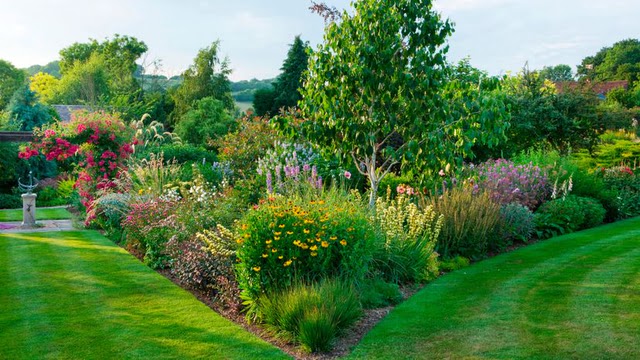
Including bird baths and other accents in your garden can enhance its overall design. Clive Nichols / Getty Images
While growing plants is great, arranging them in an attractive landscape is even better. A good landscape design has many benefits such as blending the house into the yard and increasing property values. It can also create privacy with trellises, hedges, fences, or clusters of plants acting as outdoor walls. You can even create designated areas for different activities such as composting, vegetable gardening, entertaining, or for children and pets to enjoy.
Before finalizing your garden plan, consider the needs of everyone who will use the space. Make a list of the functions that each area of your property should serve. This will help you prioritize and start designing your garden effectively.
This article covers various aspects of garden design, from planning on paper to placing different garden elements. It also discusses garden types and decorative elements such as color, shapes, paths, and fences.
For more information on creating a garden, check out:
- Gardening
- Garden Design
- Garden Types
- Annuals
- Perennials
Learn More: The Future of Gardens and Farms
As urban populations continue to grow, will we see farms designed in multi-story buildings? What are the challenges and possibilities of vertical farming? Learn more about the future of gardens and farms.
Adding Color to Your Garden
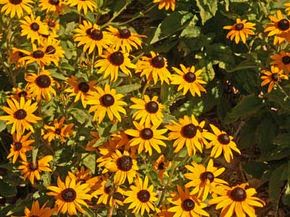
These shastas use color to make a dramatic impact, with their bright yellow petals and dark centers.
Just like selecting furnishings and paint for a room, you need to consider color, texture, and form when designing your garden. You have a wide range of options to choose from, including building materials, paving materials, types of leaves and flowers, bark textures, tree shapes, and mulch colors. Do you prefer contrasting colors, analogous colors, or a soothing blend of greens? Whatever your preference, adding color to your garden can make a dramatic impact.
To give your garden the ideal amount of attention, incorporate warm and cool colors. Warm colors, such as red, orange, and yellow, appear bold and closer than they are visually, making them ideal for a garden located farther from your home. Cool colors, such as blue and purple, recede from the eye and appear farther away, making them suitable for creating quiet gardens closer to the house. For added depth and movement, blend warm and cool colors or use analogous colors.
Texture and forms also play a crucial role in giving your garden a finished and cohesive look. Achieve repetition and continuity by using the same material in multiple elements. Vary leaf sizes for added interest and use large flowers for a bold statement and smaller flowers for depth. Determine your personal style and choose a theme that complements your landscape.
Looking for more guidance on creating your garden? Check out:
- Gardening
- Garden Design
- Garden Types
- Annuals
- Perennials
Determining Your Garden Style
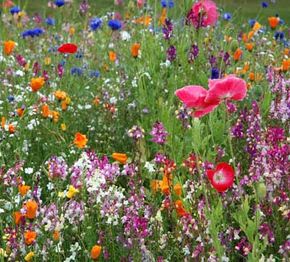
If you dream of a garden filled with vibrant wildflowers, you might be inspired by a naturalistic garden style.
Before you start picking out plants and accessories for your garden, consider your personal preferences, the look of your home, and how much maintenance work you’re willing to take on. For example, if you love the look of stylized topiaries, keep in mind that they require frequent trimming to keep their shape, whereas naturalistic, dwarf plants require less upkeep. Garden styles vary across different regions and time periods. If you’re aiming for a historically accurate garden, opt for old-fashioned plants instead of modern cultivars that weren’t available during that time period.
Plant and accessory trends come and go, just like fashion trends. For a cohesive look, it’s a good idea to choose a garden style that fits your personal taste and blends well with your landscape. On a large property, you might opt for a formal garden style near the house and a more natural, informal style further out to blend in with the surrounding countryside.
While some gardeners enjoy the clean lines and symmetry of a formal garden, keep in mind that this style requires more maintenance work. To learn more, continue reading on the next page.
Looking for more guidance on creating your garden? Check out:
- Gardening
- Garden Design
- Garden Types
- Annuals
- Perennials
Formal Gardens

Formal gardens often feature classic garden accessories such as bird baths.
A formal garden is characterized by its neat, geometric layout and symmetrical design. It often incorporates classic garden accessories, such as matching urns on either side of an entranceway. Paths in a formal garden typically lead to finely crafted benches or gazebos.
Massed ground covers, evenly spaced trees or shrubs along a driveway, and well-manicured lawns are common features in a formal garden. Evergreens like boxwood are popular choices for maintaining the formal style. Pavements for pathways and terraces may be made of brick, stone, or concrete. Outdoor furniture in a formal garden is typically classic and sophisticated. Whimsical touches, like painted plywood cutouts, are not typically found in a formal garden.
If the formal garden style isn’t your cup of tea, you might prefer an informal garden style. Read on to learn more on the next page.
Need more guidance on creating a garden? Check out:
- Gardening
- Garden Design
- Garden Types
- Annuals
- Perennials
High Speed Gardening: Quick Preview with Seed Catalog Pictures
For a fast preview of your flowerbed designs, use last year’s seed catalogs’ color pictures. Cut out the images of plants that interest you and experiment with different positions on graph paper. When you find the best combinations, use them as a starting point for your design.
Informal Gardens

This informal garden features a variety of plants that grow naturally to frame a pathway.
An informal garden is characterized by asymmetrical design elements, naturally shaped plants and beds, curved spaces, rustic furnishings, and casual pavings like decking or wood chips. It can be colorful or low-key depending on the gardener’s preferences.
The furniture used in informal gardens can be modern or traditional, but it should be comfortable-looking. This style often incorporates unique accents, such as a back-door frame painted to match nearby plants or a sweeping band of tall ornamental grasses.
Whether you prefer a formal or informal garden, it’s important to create a landscape plan to help you determine the placement of your plants and accents. The following sections offer advice on creating your plan.
Need more guidance on creating a garden? Check out:
- Gardening
- Garden Design
- Garden Types
- Annuals
- Perennials
Landscape Plans
A landscape plan can include softscapes such as plants, hedges, mulches, flower beds, ground-cover beds, and shrub or flower borders. Planning softscapes requires knowledge of soil quality, plant material, and design principles.
Hardscapes, the other important aspect of landscape design, include patios, walkways, stairways, decks, walls, fences, pools, driveways, built-in planters, and parking areas. Major changes in hardscape require engineering expertise and precise measurements of foundation footings and soil settlement ratios. It’s best to have a professional landscape architect design and supervise large hardscape projects, unless you have extensive experience and skill. Gardeners can handle smaller hardscape projects such as edging beds and creating paths without much difficulty.
Both softscape and hardscape projects should be planned out on paper before you start digging or ordering materials. On the next page, you’ll learn how to create your own garden plan.
Looking for more information on creating a garden? Check out:
- How to Use Garden Accents in Your Design
- Gardening Tips
- Garden Design Ideas
- Types of Gardens
- Annual Plants
- Perennial Plants
Creating a Garden Plan: Step-by-Step Guide
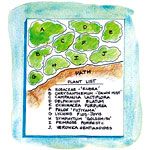
Creating a landscape plan is essential in placing garden elements in the right locations.
Before you start buying and planting, it’s important to create a map of your property and decide where your new garden features, beds, and plantings will go. The map should be a miniature replica of your property, drawn to scale. Many designers use a scale in which 1/4 inch on the plan equals one foot in your landscape. This scale provides enough detail but may require oversized paper. You can tape multiple sheets of graph paper together to get the desired size.
This is also the perfect opportunity to evaluate your current layout and decide what to keep or eliminate. Take a critical look at everything and determine if it looks good, is in good shape, fits your plan, and should be retained. You have four options with every feature: keep it, improve it, move it, or get rid of it. It’s important to consider the maturity of trees before cutting them down, as their replacement may take years to grow. If they are diseased or damaged, they may not be salvageable.
Once you have your measurements and know what you want to keep and change, you can start on your scale drawing. Even if you’re not an artist, the tips on the next page will help you create a neat drawing.
Looking for more information on creating a garden? Check out:
- Gardening Tips
- Garden Design Ideas
- Types of Gardens
- Annual Plants
- Perennial Plants
How to Create a Scale Drawing of Your Garden
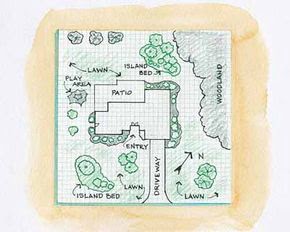
Creating a scale drawing will ensure that everything fits perfectly in your garden.
Using a scale drawing is crucial in getting precise measurements for each garden feature. It’s important to create a map of your garden before starting any work. Here’s how you can become a skillful draftsman, even if you’re an amateur gardener.
To plan your garden, start by measuring the yard using a measuring tape and sketching the perimeter on graph paper. Draw in existing trees, shrubs, fences, and other features that you want to keep. Trees and shrubs should be represented as circular blobs, and fences should look linear. Make copies of your sketch and experiment with designs by penciling in possible bed outlines and plants. Once you’ve decided on the bed locations, draw in the plants at the proper spacing and get an accurate count of how many plants you’ll need. Computer programs are available for home landscapers to test various designs from natural and overhead views.
Create a relationship diagram showing the general location of the elements you need in relation to the house and to each other. Consider the amount of maintenance time you plan to spend in the yard. The next step is garden placement. Consider the physical and geological conditions and the grass. Certain kinds of gardens can only be placed in specific exposures. Be sure to match the flowering plant to the site as most flowers are high-performance plants, sensitive to inadequacies in light, moisture, soil, or other elements. In the following section, we shall take a look at how to develop your ideas for your garden design and make them workable with the space that you have.
Looking for more information about creating a garden?
- Gardening
- Garden Design
- Garden Types
- Annuals
- Perennials
Do You Need Grass?
Some gardeners feel that having a lawn is a must-have in their outdoor space, while others don’t mind not having one. Grass requires regular maintenance, but it also has its benefits. It provides a nice, soft surface for walking and playing, and it looks great when paired with flowers, ground cover, shrubs, and trees. However, for smaller spaces, gardens without grass can be just as pleasant and successful, especially if you have paved areas and paths between garden beds and features. Some gardeners prefer to focus on caring for garden beds and containers of flowers instead of mowing the lawn. In shady gardens, moss can be used as a substitute for grass.
Developing Your Garden Design Ideas

Cutting and pasting your ideas is a great way to spend winter.
As you come up with ideas for your garden, try using actual images of your yard. Take photos and make photocopies of them. You can capture the entire front or backyard, the plantings near the house’s foundation, or individual gardens. Enlarge the photos and sketch in new plants to get an idea of how they will look. Winter is a great time to do this because even though your yard may be dormant, you won’t forget how it looks during other seasons.
If your house is visible from the street, you have a public view area. Think of your house or front door as the focal point of a picture. You’ll want to frame the view and draw attention to your house. Foundation plantings are typically set at the base of the house to frame it and connect it to the landscape. Foundation plantings can include a mix of small evergreens, flowering shrubs, ornamental trees, ground covers, and herbaceous plants. When selecting trees, consider the amount of shade they provide. Deciduous trees will shade your home in the summer while allowing sunlight in during the winter. Make sure to screen service areas such as trash cans or laundry lines from public view with shrubs or fencing.
You’ll also want to create other areas in your landscape for outdoor living. You may want to include a service area, such as a toolshed or clothesline, that is convenient to the house but away from private entertaining and public view. Landscape designs could also include work areas, places for composting, plant propagation, vegetable gardens, or even places to store trash cans and other less-than-decorative items. If you have a spectacular view of a lake or farm, don’t obstruct it with too many fences and shrubs. Instead, use plantings to frame the view off to the sides.
If you’re designing a landscape for children, you may want to include a swing set or sandbox. There are natural-looking designs that blend well with the surroundings. It’s best to place the children’s area away from heavy foot traffic, but still in plain sight for easy supervision. Use a dwarf shrub border to separate the dining and entertaining area from the children’s area. This provides privacy while still allowing you to keep an eye on the kids. A great idea for a sandbox is to make it look like a raised bed, visible from the outdoor dining area. Instead of plants and mulch, fill it with sand and let the kids play.
A private dining and entertaining area is a common feature of a well-planned landscape. Treat it like you would a comfortable room in your home and choose the size based on the number of people you will host. A patio with a nearby lawn is a good option for larger gatherings. Trees and screening materials can provide shade and privacy, and the furniture and decor should match the style of the house.
It’s important to consider the shapes of your garden beds and lawn, as they contribute to the overall look of your landscape. The lawn’s shape should set the tone for the beds, with gradual curves and straight lines providing a pleasing and easy-to-maintain look. Avoid sharp turns and jagged corners. Don’t use too many small or mismatched shapes. Sloping properties can be landscaped with flowing, curved beds and walkways that follow the contours of the land. Proportions are also important, and the next page provides guidelines for sizing your garden features.
Need more guidance on creating a garden? Check out:
- Gardening
- Garden Design
- Garden Types
- Annuals
- Perennials
Garden Proportions

©2007 Jupiter Images Corporation Flower beds, borders, and paths all contribute to the structure of your garden.
Getting the proportions of your garden features right can be challenging. Avoid overcrowding your garden with too many small shapes. Follow these general rules:
Island Beds
Ensure that island beds are half as wide as the distance from which they will be viewed. These beds are typically oval or kidney-shaped and positioned on sections of lawn that can be seen from all sides. They may be located near a corner of your yard, driveway or entrance walkway. Regardless of their placement, island beds must be wide enough to look substantial from your house, patio, or kitchen window, wherever you tend to observe them from. A small garden located far from the house is more amusing than attractive. For example, if an island bed is 20 feet away, make it 10 feet across. In large gardens, place island beds closer to the house if you lack the time to maintain a large island bed.
Borders
Borders can take up to half of the area in a small to medium-sized yard. For instance, a 40-foot-wide yard could have one 20-foot-wide border or two 10-foot-wide borders. Borders—traditional gardens usually set at the edge of a yard, fence, or hedge—must also have enough size to be in proportion and make an impact in the yard. Wider borders can hold taller plants such as trees, shrubs, large clumps of perennials, and ornamental grasses, creating a rich diversity.
Another factor in garden design is designing pathways. Consider different types of suitable paving, shapes, and sizes when planning your paths. Learn more about it on the next page.
Need more guidance on creating a garden? Check out:
- Gardening
- Garden Design
- Garden Types
- Annuals
- Perennials
Garden Paths
Construct garden paths in any area that receives enough foot traffic to wear out the grass. Paths create pleasant straight or curved lines through the yard and make it easier to navigate in wet weather. They also save you the trouble of constantly reseeding worn-out areas.
If you have a large property, ensure that paths are wide enough for two people to walk side by side. If your path is made of grass, ensure that it is wide enough for a lawn mower to pass through. Incorporate turns or curves in your paths so that part of the view comes as a surprise while walking. Terraces and patios should also have an uncluttered feel, with enough space for furniture and additional space for walking around tables and chairs. Include extra space for container gardens.
Paving materials come in various styles, prices, ease of installation and maintenance, and appearance. Here are four popular options:
The walkway can have a casual or formal appearance depending on the type of stones used. Irregular flagstones give a casual look, while rectangular stones are used for a more formal appearance. Brick paving, which is durable and formal, can have several patterns and edgings. Simple styles are recommended. Paving bricks are wider and flatter than the ones used for buildings. Recycled or antique bricks can also be used. Concrete sidewalks are a good-looking and practical option, and are usually less expensive than brick or stone. Wood or bark chips can create a casual path that is permeable and environmentally friendly. However, the chips break down over time, so a new layer must be added occasionally. When it comes to fencing, there are several types to choose from, such as wood or plastic timber. Cedar and redwood are better woods that last longer. A stockade fence is practical for total privacy, while picket fences have a friendly feeling and mark property lines. Rustic cedar split-rail fences are simple and inexpensive, and can be used to outline pastures for cattle and horses. A “good neighbor” fence looks the same from both sides and is a popular option for neighbors to share the cost.
Looking for further guidance on how to cultivate a garden? Consider exploring:
- Gardening techniques
- Garden planning
- Various garden styles
- Annual plants
- Perennial plants
FAQ
1. What are the basic principles of garden design?
Garden design is all about creating a harmonious and functional outdoor space that suits your needs and preferences. The basic principles of garden design include balance, proportion, unity, focalization, rhythm, and repetition. Balance is achieved by distributing the elements of your garden evenly, while proportion refers to the size and scale of the various components. Unity is created through the use of consistent materials and colors, while focalization draws the eye towards a specific feature. Finally, rhythm and repetition provide structure and coherence to the overall design.
2. How do you choose the right plants for your garden?
Choosing the right plants for your garden depends on several factors, including your climate, soil type, and the amount of sunlight your garden receives. You should also consider the size, color, and texture of the plants, as well as their growth habits and maintenance requirements. Choose plants that are well-suited to your garden’s conditions and that will complement the overall design of your space.
3. What are some common garden design mistakes to avoid?
Common garden design mistakes include overcrowding, using too many different materials or colors, neglecting the importance of focal points, and failing to consider the maintenance requirements of your plants and materials. Avoid these mistakes by creating a clear plan for your garden, paying attention to the principles of design, and selecting materials and plants that are well-suited to your climate and maintenance abilities.
4. How can you create a low-maintenance garden?
To create a low-maintenance garden, choose plants and materials that require minimal care and attention. Use native plants that are well-suited to your climate and soil type, and opt for hardy, disease-resistant varieties. Consider using hardscaping elements such as gravel or stone pathways, as well as low-maintenance materials like composite decking or recycled plastic furniture. Finally, reduce the size of your lawn and replace it with low-maintenance groundcover or garden beds.
5. How can you incorporate water features into your garden design?
Water features can add a beautiful and tranquil element to your garden design. Consider incorporating a small pond, fountain, or waterfall into your space, and choose materials and plants that complement the water feature. Be sure to also consider the maintenance requirements of your water feature, as well as the safety considerations for children and pets.
6. How can you create a garden that attracts wildlife?
To create a garden that attracts wildlife, incorporate plants that provide food and shelter for birds, butterflies, bees, and other creatures. Choose native plants that are well-suited to your climate and that provide nectar, pollen, and seeds for wildlife. You can also add bird feeders, birdhouses, and butterfly houses to your garden to encourage even more wildlife to visit.
7. How can you create a garden that is functional for entertaining?
To create a garden that is functional for entertaining, consider adding a patio or deck area, as well as comfortable seating and dining areas. Use lighting to create a warm and inviting ambiance, and consider adding a barbecue or outdoor kitchen for cooking and entertaining. Finally, choose plants and materials that are low-maintenance and easy to clean.
8. How can you create a garden that is eco-friendly?
To create an eco-friendly garden, choose native plants that require minimal water and fertilizer, and avoid using pesticides and herbicides. Use compost and other organic materials to enrich your soil, and consider using rain barrels or other water-saving devices to conserve water. You can also incorporate recycled materials into your garden design, such as reclaimed wood or recycled plastic furniture.
9. How can you create a garden that is accessible for those with disabilities?
To create a garden that is accessible for those with disabilities, consider adding ramps, wide pathways, and raised garden beds. Use non-slip materials for walkways and patios, and ensure that your garden has adequate lighting for those with visual impairments. Choose plants that are easy to reach and maintain, and consider adding garden tools that are designed for those with disabilities.
10. How can you create a garden that is safe for children and pets?
To create a garden that is safe for children and pets, choose non-toxic plants and avoid using pesticides and herbicides. Use non-slip materials for walkways and patios, and ensure that your garden has secure fencing or other barriers to prevent children and pets from wandering off. Finally, supervise children and pets when they are in the garden, and consider adding a designated play area away from potentially hazardous plants or features.

Brody is a skilled craftsman and gardening expert. From renovating living spaces to cultivating lush gardens, Brody’s knowledge and passion shine through, inspiring readers to embark on their own home improvement and gardening journeys with confidence.






Leave a Reply